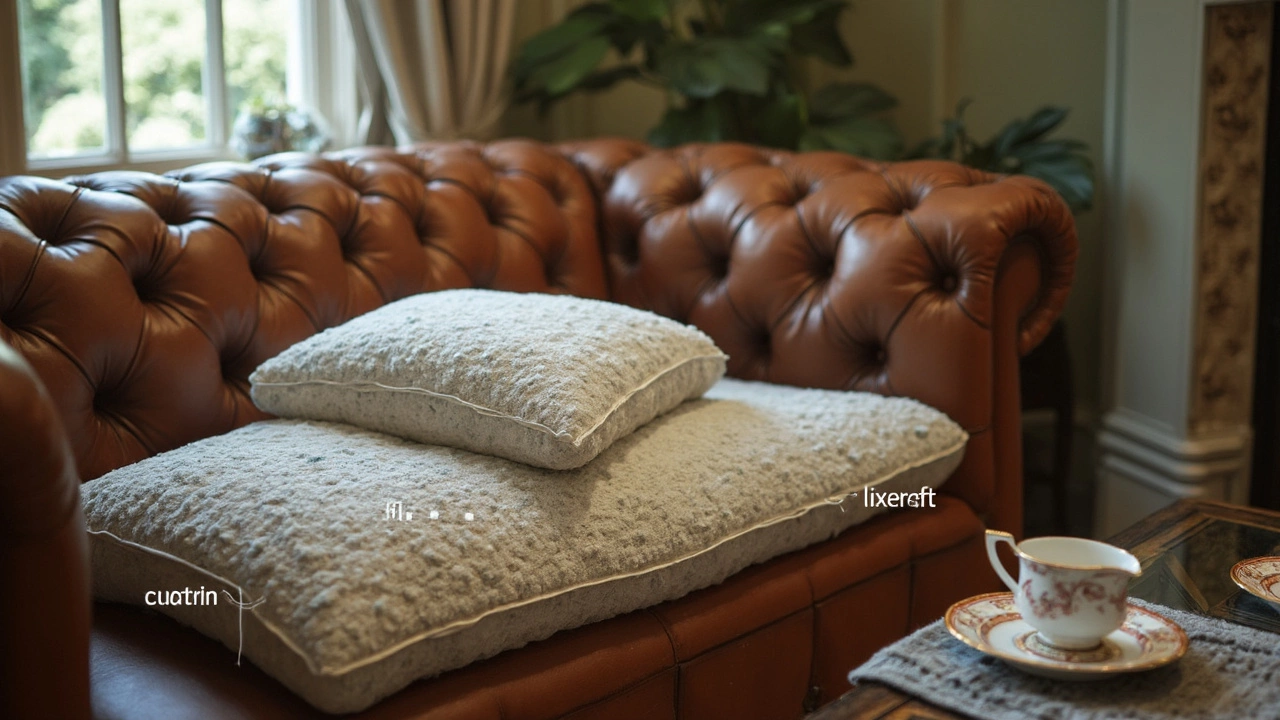Ever sat on a couch and felt like you were sinking right into it, or maybe it was way too firm? That feeling often boils down to the foam density of your seat cushions. Foam density is all about the weight per cubic foot of the foam. It’s a big player in how your couch ends up feeling – whether it's firm, plush, or somewhere in between.
If you're shopping for new seat cushions or just curious about your sofa's guts, getting a handle on foam density can be a real game-changer. Typically, you'll find foam density ranges from 1.0 to 2.5 pounds per cubic foot. Lower density, like 1.0 to 1.5, might seem softer at first, but it can wear out pretty quick. Higher densities, such as 2.0 or more, offer firmer support and tend to last longer.
But wait, what about comfort? That's where things get personal. Some folks love sinking into a soft cloud, while others need a firmer seat for back support. So, it’s not just about durability but what feels good to you. Plus, your cushion needs might change depending on where your couch is – a lounge piece might need softer foam, while a formal living room setup could do with something firmer.
- Understanding Foam Density
- Types of Foam for Cushions
- Pros and Cons of Different Foams
- Choosing the Right Foam for You
- Tips for Maintaining Your Seat Cushions
Understanding Foam Density
Alright, let’s break down the basics of foam density. It all comes down to how heavy a cubic foot of the foam is. More precisely, density is measured in pounds per cubic foot (PCF). So, if a piece of foam weighs 2 pounds and it's a cube that's a foot on each side, its density is 2 PCF.
Why does it matter? Well, density foam gives you an idea of how durable and supportive a foam is going to be. Generally, higher density equals more durability and longevity, which means it won’t lose its shape as fast as less dense foams. This can be crucial if you don’t want to end up with saggy cushions after a few months.
As Amanda Johnson, a foam industry expert, says, "High-density foam is your best friend if you value both support and longevity in your seat cushions."
Breaking Down the Numbers
In the world of sofa cushions, density usually ranges from 1.0 to 3.0 PCF. Here’s a quick cheat sheet:
- 1.0 to 1.5 PCF: Super soft and squishy, think of them as the marshmallow of foams. Nice for those who like a really soft seat, but don't expect these to hold their shape long-term.
- 1.5 to 2.0 PCF: A middle-ground option—soft yet reasonably durable. Perfect for everyday casual use.
- 2.0 to 3.0+ PCF: Firm and supportive, ideal for formal sitting areas or where seats see a lot of use. They can take a beating and bounce back nicely.
So, whether your goal is longevity, an ideal plush feel, or somewhere in-between, understanding these numbers can help you make an informed choice for your sofa cushions. Don’t forget, though, density isn’t the be-all and end-all. It’s also about finding what feels right when you sit on it every day.
Types of Foam for Cushions
When it comes to picking the right foam for your seat cushions, you'll find there's more than just density to think about. Let’s explore some common types of foam that are popular in sofas and chairs.
Polyurethane Foam
Polyurethane foam is probably the most common type you’ll come across. This type of foam is versatile and comes in various densities and firmness levels. It’s relatively affordable but might not stand the test of time, especially if you're spending a lot of time on your couch.
Memory Foam
Ever heard of memory foam for beds? Well, it’s making its way into seat cushions too. Memory foam molds to your body, giving you that customized feel. It's all about comfort and support, but some people find it’s a bit too soft for sitting over long periods.
High-Resilience Foam
If you’re looking for something that’s going to last, high-resilience foam might be your best bet. Known for its durability and excellent support, it bounces back pretty well after use. It’s on the pricier side, but if your sofa sees a lot of action, this could be a smart investment.
Latex Foam
Latex foam is another option, offering a firm and bouncy feel. It's also durable and doesn’t retain heat, keeping you cooler. Plus, it's often made from natural materials, so it's a good choice if you're looking for something eco-friendly.
Open-Cell Foam
Open-cell foam has a more spongy texture and can offer good airflow, which helps with cooling. It’s softer and is often used to provide that first layer of comfort above harder foam layers.
Choosing the right type of foam depends on what you value more – durability, comfort, budget, or maybe temperature regulation. But whatever your preference, knowing what’s out there helps you make a choice you'll be happy plopping down on at the end of the day!

Pros and Cons of Different Foams
When it comes to picking the right foam density for your seat cushions, it's like picking the right mattress. There's a bit of science and personal taste involved. Let's break down some popular foams and see what makes them tick.
Polyurethane Foam
This is the most common foam and typically what you find in those budget-friendly couches. Here's the scoop:
- Pros: It's affordable, lightweight, and comes in various densities, making it versatile for different cushion needs. Plus, it's easy to cut and shape for DIY projects.
- Cons: It doesn't always wear well over time. The lower density types might develop dips, leaving your couch looking and feeling worn pretty quickly.
Memory Foam
Famed for that memorable 'sink-in' feel, memory foam can add a touch of luxury.
- Pros: Offers great comfort and pressure relief. It contours to your body, which makes for an enjoyable seating experience, especially for those lazy afternoons.
- Cons: Can retain heat, making it a bit warm for those hot summer days. It also tends to be heavier and sometimes more expensive.
High-Density Foam
Now we're talking about the foam that stands the test of time. This one caters to those who like their sofa cushions firm and long-lasting.
- Pros: Extremely durable and offers more support. It's less likely to develop those annoying dips and sagging spots, maintaining its shape for years.
- Cons: Initial cost might be higher and the feel can be a little firm for some folks. Not everyone loves a solid seating experience.
Here's a quick comparison to make things clearer:
| Foam Type | Durability | Comfort | Cost |
|---|---|---|---|
| Polyurethane | Moderate | Varies | Low |
| Memory Foam | High | High | Medium |
| High-Density | Very High | Firm | High |
So, when scouting for sofa cushions, remember it's a balance of what feels right for your bum and what fits your budget. Think about where your sofa sits in your home, how often it's used, and what kind of comfort you're after—this trifecta will guide you to the best choice!
Choosing the Right Foam for You
So, you’ve decided it’s time to pick the perfect foam for your seat cushions. Whether you’re revamping an old sofa or crafting your dream couch, picking the right foam density makes a big difference in both comfort and longevity. Here’s a guide to help you make the best choice.
Assess Your Comfort Level
Start by figuring out your comfort preference. Do you like to sink into a super-soft seat, or need extra support for sitting up straight? Typically, a foam density of around 1.8 to 2.5 pounds per cubic foot strikes a nice balance between comfort and durability. But if you crave more support, consider moving up toward a denser foam.
Consider Your Sofa's Use
Think about how often and how many people will use the sofa. For a main living room sofa that handles a lot of daily lounging, you might want a denser foam to withstand the wear and tear. But if it's a decorative piece, a lighter density foam could work just fine.
Check the Foam's Resilience
Foam doesn't just vary by density but also resilience. You might see terms like 'high-resilience' foam, which bounces back quicker and holds its shape over time. It's great for both comfort and longevity, making it a popular choice for high-use furniture.
Test It Out
If you can, visit stores to test different density foam options. Feel how they support your body and remember, the real test is how you feel after sitting for a while. Comfy couches should feel good long-term, not just when you first plop down.
Make It Last
Once you've chosen your seat cushions, remember to take care of them. Flipping cushions regularly prevents uneven wear, and using covers can keep them clean and extend their life. Simple steps can keep those cushions comfy for years.

Tips for Maintaining Your Seat Cushions
Keeping your seat cushions in top shape is easier than you might think. A little care goes a long way, ensuring your sofa remains comfy and looking good. Here are some straightforward tips to help you out.
Regular Fluffing and Rotation
Fluffing your cushions regularly helps maintain their shape and comfort. Every few days, give them a good shake or pat. Rotating them can also prevent uneven wear, especially in high-traffic households.
Spot Cleaning as Needed
Life happens, spills happen! Don't panic. Aim to treat stains as soon as they occur. Most cushion covers recommend simple solutions like mild soap and water, but always check the care label first. For stubborn stains, a specialized fabric cleaner might be necessary.
Protect from Sunlight
Direct sunlight can fade the fabric and weaken the foam inside. If your sofa is basking in sunlight for hours daily, consider rearranging the room to protect those seat cushions or invest in some stylish throws or covers.
Vacuum Regularly
Dust and crumbs build up faster than you'd imagine. A quick vacuum every week or so keeps dirt from settling into the foam and ensures your sofa cushions stay clean over time. Most vacuum cleaners have an attachment perfect for this task.
Invest in Quality Covers
Quality cushion covers are worth their weight in gold. They protect the foam and add a layer of style. Plus, they're often machine-washable, making them easy to clean and switch out according to your home’s decor changes.
Take these simple steps to maintain your density foam seat cushions and you'll enjoy a comfy, attractive sofa for years to come. It's all about consistent little efforts that make a big difference.
